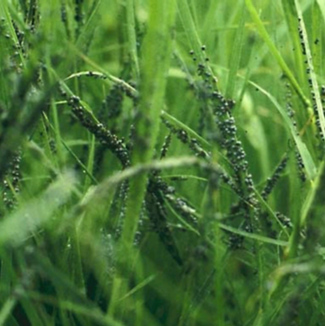
- Systematic Approach to Diagnosis of Turfgrass Diseases
- Simplified Turfgrass Disease Identification Key
- Dollar Spot
- Fairy Rings
- Take-All Root Rot
- Brown Patch/Large Patch
- Rust
- Leaf Spot/Melting Out
- Gray Leaf Spot
- Anthracnose
- Slime Mold
- Pythium Root Rot/Pythium Blight
- Disease Summary
- Georgia Turfgrass Disease Calendar
Systematic Approach to Diagnosis of Turfgrass Diseases
- Identify the host
- Some diseases are more likely to occur on certain grass species
- Define the symptoms of the problem
- Patches, yellowing, chlorosis, leaf spots, etc.
- Ask questions to narrow down the cause of the symptoms
- Could it be environmental?
- Was anything sprayed?
- When did you first notice the problem?
- Where did it start?
- Has it spread since then?
- What is your watering and fertilization schedule?
- Examine the specimen
- Collect a representative sample with a range of symptoms including leaf blades and roots.
- Use half of sample to perform diagnosis. Store rest of the sample inside a plastic bag which contains a moist paper towel.
- Using a hand lens or compound microscope, observe any fungal signs that may be present (mycelia, sclerotia, pycnidia, etc.)
- Prepare a microscope slide mount based on signs and view with compound microscope.
- Place a small drop of water or stain on the slide.
- Pull sections from the roots, blade sheath and /or crown, and any leaf spots.
- Place cover slip over mount and view beginning with smallest magnification and change magnification as the desired signs in question are found.
- Consult resources
- Use literature and resources to reach a diagnosis.
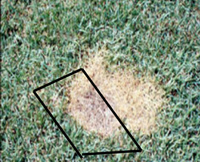 Figure 1.
Figure 1.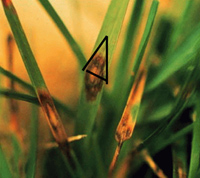 Figure 2.
Figure 2.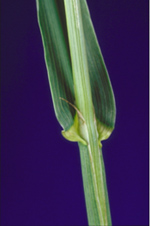 Figure 3.
Figure 3.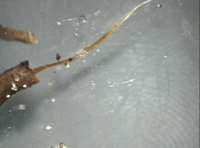 Figure 4.
Figure 4.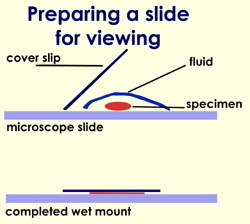 Figure 5.
Figure 5.
Simplified Turfgrass Disease Identification Key
A. Distinct patches of yellow to brown colored grass are present.
- Patch is small, circular, sunken, and rarely exceed 3 inches in diameter. Individual leaf blades develop white lesions. [Dollar Spot]
- Patch is greater than 6 cm in diameter. Individual leaf blades may or may not develop lesions.
- No lesions
- Circular rings of dark green grass 10-20 cm wide. Concentric ring of dead grass may be present. Mushrooms may be present. [Fairy Ring]
- Irregular chlorotic patches up to 0.5 m across. Lower leaves are chlorotic first and then chlorosis moves to upper leaves. Runners easily pulled from roots. Roots may be short, rotted, and black. Roots may have dark strands of mycelium parallel to the root axis. [Take-All Root Rot]
- Lesions on leaf buds or leaf blade
- Rings or circular patches of blighted grass. Gray to brown shaped lesions on leaves or leaf sheaths. [Brown Patch]
- Rings or circular patches of blighted grass. No lesions on leaves. [Large Patch]
- No lesions
B. Distinct patches are absent.
- Yellow to orange flecks on leaves or stems. Flecks are easily rubbed off. [Rust]
- Yellow to orange flecks are absent.
- Leaf lesions are present.
- Lesions first appear small and water-soaked. Old lesions become dark often surrounded by a yellow zone. Lesions have a wide range of size and primarily occur on warm season grasses in Georgia. [Leaf Spot/Melting Out]
- Small, brown leaf and stem lesions enlarge rapidly to oblong spots. Often spots extend across entire leaf. Spots are tan to gray with purple to brown borders. A general chlorosis may appear. Primarily occurs on St. Augustinegrass in summer. [Gray Leaf Spot]
- Leaf lesions are reddish brown with a yellow halo. Leaves turn yellow and finally tan to brown as they die. Primarily occurs on Centipedegrass, Bentgrass, and Zoysiagrass in Georgia. [Anthracnose]
- Leaf lesions are absent.
- Large number of pinhead-sized "balls" that are slimy or crusty. Grass does not die or turn yellow. Slime is easily removed. [Slime Mold]
- Turf is chlorotic and slow growing. Small to large areas affected. Grass may be mottled and associated with general decline. As temperature increases the affected areas will die. Roots stunted but usually not discolored. [Pythium Root Rot/Pythium Blight]
- Leaf lesions are present.
Dollar Spot
Causal Agent:
Sclerotinia homoeocarpa
Susceptible Turfgrass:
All species of warm- and cool-season turfgrass. Georgia has seen cases in Tall fescues, Bentgrass, Bermuda hybrids and Centipede.
Symptoms:
Symptoms of dollar spot includes sunken, circular patches that measure up to several inches on turfgrass. The patches turn from brown to straw color and may eventually coalesce, forming irregularly shaped areas. Infected leaves may display small lesions that turn from yellow-green to straw color with a reddish-brown border. The lesions can extend the full width of the leaf. Multiple lesions may occur on a single leaf blade. Mycelia may be present.
Conditions Favoring Disease:
Dollar spot is favored by temperatures between 60 °F to 85 °F and continuous high humidity. This disease is particularly favored by warm days, cool nights, and intense dews. When the disease is severe, it also infects turf growing in areas with low levels of nitrogen and in dry soils.
Management Tips:
- Use an adequate level of nitrogen, particularly in the spring and early summer.
- Mow grass at regular intervals.
- Reduce thatch.
- Increase the air circulation.
- Irrigate turf deeply and as infrequently as possible to avoid drought stress. Avoid frequent and shallow irrigation schedules
- Remove dew from the turf early in the day.
- Fungicides are available to control the disease. Consult the current Georgia Pest Management Handbook — commercial or homeowner version.
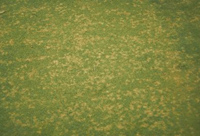 Figure 6.
Figure 6.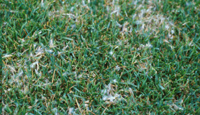 Figure 7.
Figure 7.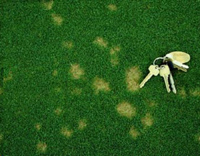 Figure 8.
Figure 8.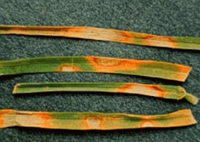 Figure 9.
Figure 9.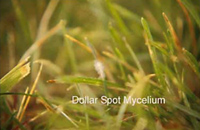 Figure 10.
Figure 10.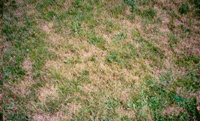 Figure 11.
Figure 11.
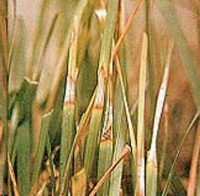 Figure 12.
Figure 12.
Fairy Rings
Causal Agent:
Basidiomycetes of more than 40 species can cause fairy rings; causal agents include: Agaricus campestris; Chorophyllum molybdites; Collybis spp.; Hygrocybe spp.; Lepiota sordida; Marasmius oreades; Psalliota spp.; Scleroderma spp.; Tricholoma spp.; Lycoperdon clitocybe.
Susceptible Turfgrass:
All species of warm- and cool-season turfgrass. Particularly damaging in Centipede and St. Augustinegrass in south and coastal Georgia
Symptoms:
Fairy ring symptoms vary with causal agents. Above-ground mushroom and puff ball basidiocarps may or may not occur. Typically, this disease has outer rings that are either dark-green or brown in color. The shape and size of the rings vary depending on the species. Activity in the turf ceases when the individual rings come in contact with each other. Some causal agents form fruiting bodies, but do not form rings. Conversely, other causal agents will form rings, but not fruiting bodies. Fairy rings are sometimes responsible for causing hydrophobic areas similar to localized dry spots.
Conditions Favoring Disease:
While fairy rings typically occur in the summer, this disease can also occur on cool-season turfgrass in mild winter climates.
Management Tips:
- Avoid using root zone mixes with high levels of undecomposed organic materials.
- Reduce thatch by vertical cutting.
- Aerate soil.
- Irrigate deeply.
- Use nitrogen fertilizer to mask symptoms on some types of fairy ring.
- Use soil wetting agents to help penetrate hydrophobic areas.
- Fungicides are available to control the disease. Consult the current Georgia Pest Management Handbook — commercial or homeowners version.
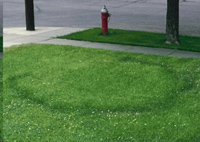 Figure 13.
Figure 13.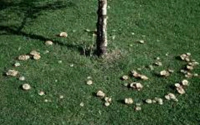 Figure 14.
Figure 14.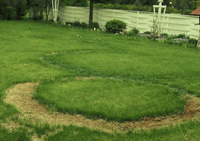 Figure 15.
Figure 15.
Take-All Root Rot
Causal Agent:
Gaeumannomyces graminis var. graminis.
Susceptible Turfgrass:
St. Augustinegrass, Bermudagrass and Centipedegrass. Bluegrass and Fescues are rarely affected in Georgia.
Symptoms:
Take-all patch causes wilted, circular patches that are brown or bronze-colored and measure up to several feet in diameter. Infected plants have dark-brown roots.
Conditions Favoring Disease:
Take-all root rot typically occurs in wet conditions and in areas with a high soil pH — most severe at pH 6.5 or above. This disease is more severe on less fertile and sandy soils.
Signs:
Strands of darkly pigmented, ectotrophic, runner hyphae can be seen on roots, stolons, and rhizomes both with the dissecting and compound microscope. Infection hyphae originate from lobed hyphopodia.
Management Tips:
- Use acidifying fertilizers.
- Apply moderate to high levels of phosphorous, potash and minor elements where these nutrients are depleted from the soil.
- Improve the drainage of the turf.
- Reduce thatch.
- Fungicides are available to control the disease. Consult the current Georgia Pest Management Handbook — commercial or homeowner version.
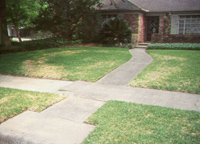 Figure 16.
Figure 16.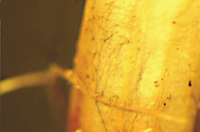 Figure 17.
Figure 17.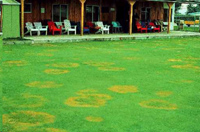 Figure 18.
Figure 18.
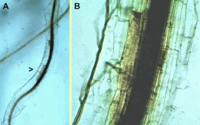 Figure 19.
Figure 19.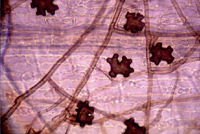 Figure 20.
Figure 20.
Brown Patch/Large Patch
Causal Agent:
Rhizoctonia solani
Susceptible Turfgrass:
Brown patch: All species of cool-season turfgrass.
Large Patch: All species of warm-season turfgrass.
These are the most frequently diagnosed diseases on turf samples at University of Georgia Disease Clinics.
Symptoms:
Brown Patch: The symptoms of brown patch can vary depending on the grass cultivar, climatic and atmospheric conditions, and soil management of the turfgrass. This disease typically causes rings and/or patches of blighted turfgrass that measure 5 inches to more than 10 feet in diameter. It also causes leaf spots and "smoke rings" — thin, brown borders around the diseased patches that appear most frequently in the early morning. After the leaves die in the blighted area, new leaves can emerge from the surviving crowns. On wide bladed species, leaf lesions develop with tan centers and dark brown to black margins.
Large Patch: Large patch occurs during the spring and fall, when warm-season turfgrasses are entering or exiting their period of winter dormancy. Circular patches of diseased turf are observed, ranging in diameter from less than 3 ft. up to 25 ft. Leaves of recently infected turf, located at the periphery of the patch, may appear orange in color. Some patches may be perennial, recurring in the same location and expanding in diameter year after year. In contrast to brown patch, R. solani infection of warm-season grasses occurs on the leaf sheaths, where water-soaked, reddish-brown or black lesions are observed. Foliar dieback from the leaf tip toward the base occurs as a direct result of these leaf sheath infections.
Conditions Favoring Disease:
Brown patch favors high relative humidity as well as temperatures of over 80 °F during the day and over 60 °F at night. This disease can be quite active at cool temperatures on warm season grasses in the spring and fall. It also occurs in areas that experience more than 10 hours a day of foliar wetness for several consecutive days. Brown patch infestation is more severe when the turf is cut to a height less than the optimum for the turf-grass being grown. Large patch is favored by high relative humidity as well as temperatures of over 80 °F during the day and over 55 °F at night.
Signs:
Rhizoctonia produces distinct mycelia with three characteristics for diagnostics. Rhizoctonia always has septate hyphae that branch at 90-degree angles, constrictions at the base of the branching, and is tan to light brown color.
Management Tips:
- Use low to moderate amounts of nitrogen, moderate amounts of phosphorous and moderate to high amounts of potash.
- Avoid nitrogen applications when the disease is active.
- Increase the height of cut.
- Increase the air circulation.
- Minimize the amount of shade.
- Irrigate turf early in the day.
- Improve the drainage of the turf.
- Reduce thatch.
- Apply lime if soil pH is less than 6.5
- Remove dew from turf early in the day.
- Fungicides are available to control the disease. Consult the current Georgia Pest Management Handbook — commercial or homeowners version.
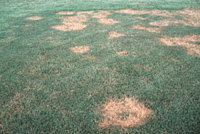 Figure 21.
Figure 21.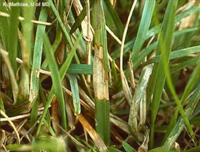 Figure 22.
Figure 22.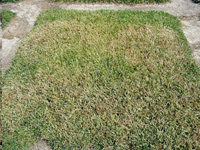 Figure 23.
Figure 23.
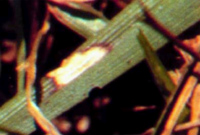 Figure 24.
Figure 24.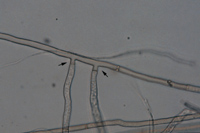 Figure 25.
Figure 25.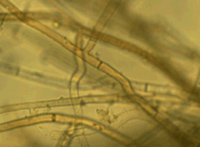 Figure 26.
Figure 26.
Rust
Causal Agent:
Puccinia spp., Uromyces spp.
Susceptible Turfgrass:
Bluegrass, Ryegrass, Bentgrass, Zoysiagrass, Bermudagrass and Fescue
Symptoms:
Rust diseases initially cause light-yellow flecks on the leaf blades and sheaths. The flecks enlarge, elongate, and turn yellow in color. The infected areas raise above the epidermis and then rupture, releasing spores that are yellowish-orange to reddish-brown in color. The leaf blade turns yellow starting at the tip and progressing to the base. A severe disease infection can cause the shoot to turn yellowish to reddish-brown in color and slow in growth. As individual plants die, the turf thins.
Conditions Favoring Disease:
Rust diseases typically occur in early spring through mid-summer, depending on the location of the turf. Rusts favor moist, low-light areas. Depending on the species, rusts favor temperatures between 65 °F and 85 °F. Severe rust infections occur on slow-growing turfgrass particularly those with low nitrogen levels and/or plant water stress.
Signs:
Teliospores of Uromyces and Puccinia are one- and two-cells respectively. Spores are orange-red in color and circular to ovoid in shape.
Management Tips:
- Apply adequate levels of nitrogen.
- Remove clippings from turf.
- Reduce thatch.
- Reduce shade and improve air circulation.
- Regulate irrigation to minimize the amount of time moisture remains on the leaf surface.
- Water deeply and infrequently.
- Fungicides are available to control the disease. Consult the current Georgia Pest Management Handbook — commercial or homeowner version.
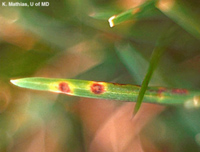 Figure 27.
Figure 27.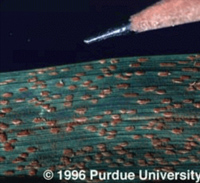 Figure 28.
Figure 28.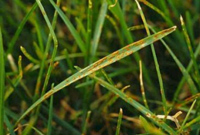 Figure 29.
Figure 29.
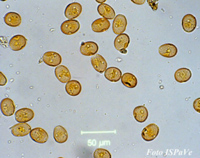 Figure 30.
Figure 30.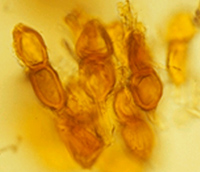 Figure 31.
Figure 31.
Leaf Spot/Melting Out
Causal Agent:
Curvularia spp., Drechslera spp. and/or Bipolaris spp.
Susceptible Turfgrass:
Creeping red fescue, Kentucky bluegrass, Perennial ryegrass, Tall fescue and all varieties of Bentgrass, Bermudagrass and Bluegrass, Zoysiagrass and Centipede.
Symptoms:
Leaf spot symptoms include purplish-brown to black spots with tan centers on the leaf blade and sheath. The lower leaves of the infected plants become shriveled and blighted. Severe leaf spot can lead to melting-out when leaves and tillers are infected, causing severe thinning of the stand. On cool season turfgrass, melting-out typically follows the appearance of leaf spots.
Conditions Favoring Disease:
Disease occurs at temperatures between 40 °F and 80 °F in areas that experience more than 10 hours a day of foliar wetness for several consecutive days. The disease is favored by high amounts of nitrogen and a low mowing height.
Signs:
Conidiophores are light to darkly pigmented. Conidia vary from curved with three vertical septations to multi-celled, ovoid and cylindrical.
Management Tips:
- Reduce turf stress by using lightweight equipment.
- Increase air circulation to speed turf's drying process.
- Do not apply high rates of water-soluble nitrogen in the spring.
- Minimize the amount of shade.
- Irrigate turf deeply and as infrequently as possible.
- Reduce thatch in the early spring or fall for cool-season turfgrass and in the summer for warm-season turfgrass.
- Avoid using systemically translocated fungicides, plant growth regulators and herbicides.
- Fungicides are available to control the disease. Consult the current Georgia Pest Management Handbook — commercial or homeowner version.
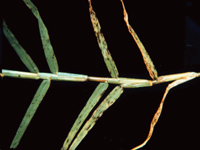 Figure 32.
Figure 32.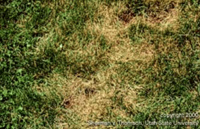 Figure 33.
Figure 33.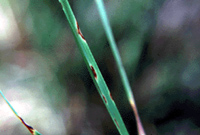 Figure 34.
Figure 34.
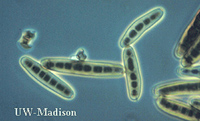 Figure 35 Drechslera.
Figure 35 Drechslera.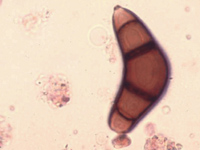 Figure 36 Curvularia.
Figure 36 Curvularia.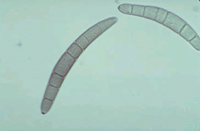 Figure 37 Bipolaris.
Figure 37 Bipolaris.
Gray Leaf Spot
Causal Agent:
Pyricularia grisea
Susceptible Turfgrass:
St. Augustinegrass, Perennial ryegrass, Bermudagrass, Centipedegrass, Bentgrass and various species of Fescue
Symptoms:
The symptoms of gray leaf spot vary depending on the grass cultivar. On St. Augustinegrass, gray leaf spot first appears as small, brown spots on the leaves and stems. The spots quickly enlarge to approximately ¼ inch in length and become bluish-gray in color and oval or elongated in shape. The mature lesions are tan to gray in color and have depressed centers with irregular margins that are purple to brown in color. A yellow border on the lesions can also occur. In cool-season turfgrass, the symptoms are similar to those of melting-out.
Conditions Favoring Disease:
Gray leaf spot is favored by daytime temperatures between 80 °F to 90 °F and night temperatures above 65 °F. It is also found in areas with high nitrogen levels and that are stressed by various factors, including drought and soil compaction. This disease is most severe during extended hot, rainy and humid periods.
Signs:
Conidia are produced on the terminal ends of conidiophores which are long and slender. Conidia are ice cream cone-shaped or bowling pin-shaped and usually 2 to 3 celled. Conidia are attached to the conidiophores at the robust end.
Management Tips:
Status and Revision History
Published on Aug 14, 2003
Published on May 04, 2009
Published on Oct 01, 2009
Published with Full Review on May 21, 2012
Published with Full Review on Jan 30, 2017
Published with Full Review on May 29, 2020


























































